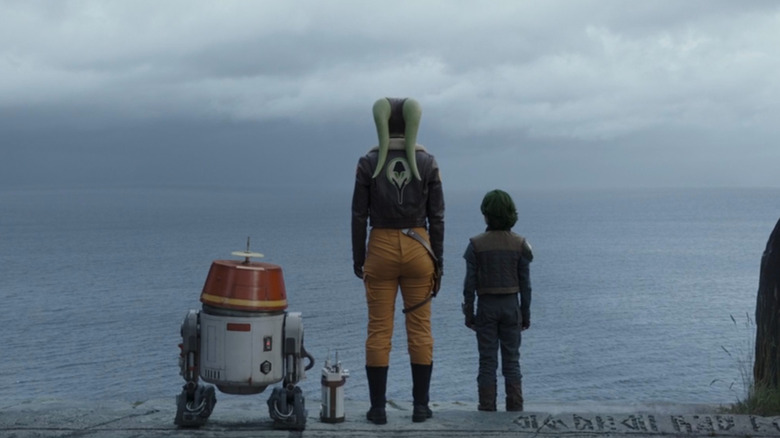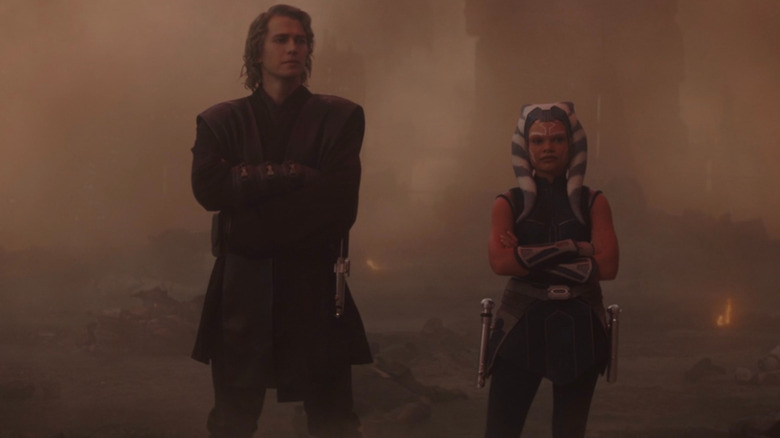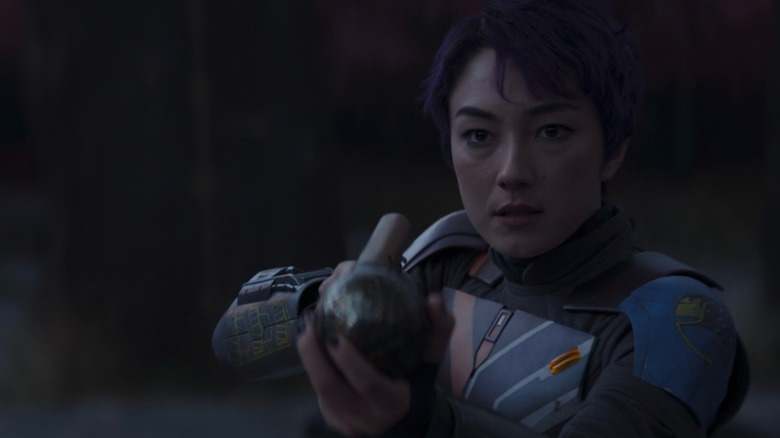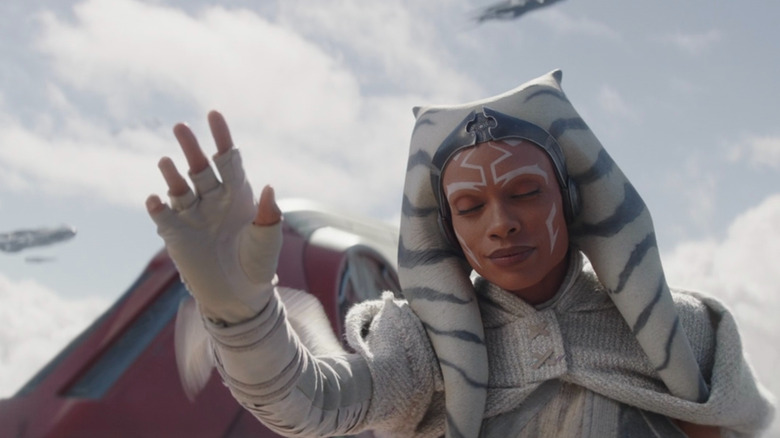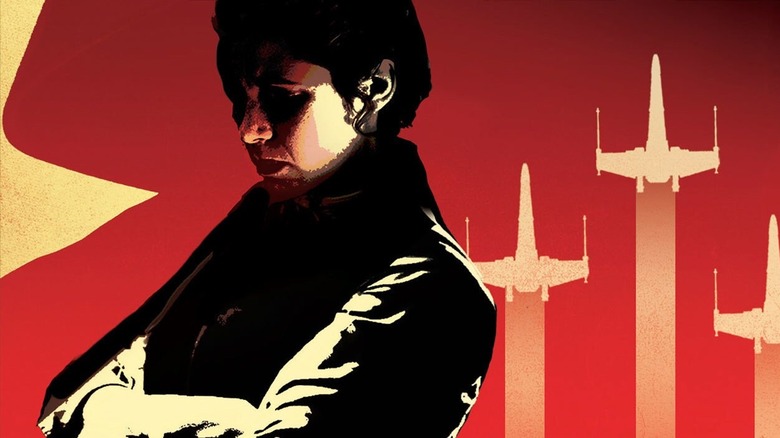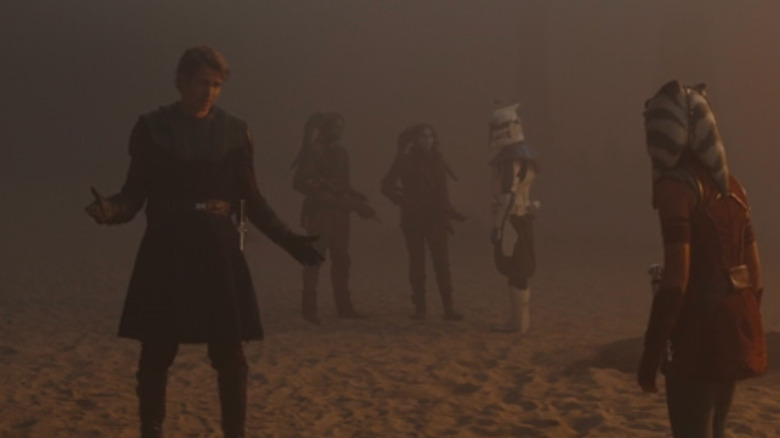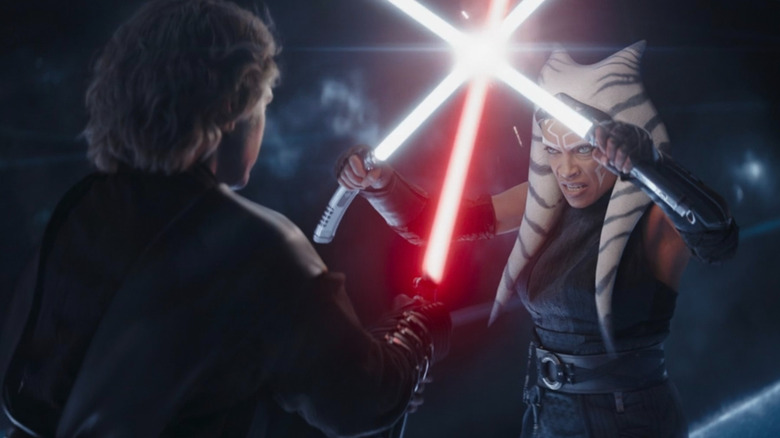Ahsoka Proves It's The Perfect Successor To Star Wars Rebels With 'Shadow Warrior'
This article contains spoilers for "Star Wars: Ahsoka" episode 5 — "Shadow Warrior."
After last week's bombshell reveal of Anakin Skywalker (Hayden Christensen), we were all left scratching our heads wondering exactly what happened to Ahsoka (Rosario Dawson) and how things would play out now that reinforcements in the form of Hera Syndulla (Mary Elizabeth Winstead) and Carson Teva (Paul Sun-Hyung Lee) had arrived. The first half of this episode is split into two, with Ahsoka in a netherworld of the Force, grappling with her inner conflicts in the form of her old master as she struggles to survive in one part. In the other, we see Hera, Carson, and the rest desperately seeking any sign of Sabine and Ahsoka. It's young Jacen Syndulla (Evan Whitten) who realizes that she's waging a battle somewhere in the water, reliving moments of her life during the Clone Wars and the Siege of Mandalore, all while fighting with Anakin Skywalker — or Darth Vader.
Eventually, they pluck Ahsoka from the water as she's defeated the darkness inside of her left by her master, giving her the chance to live. As she recovers, they seek answers about Sabine and where she went and quickly discover that she left the galaxy with Morgan Elsbeth and the others.
Seeking a way to go after Sabine, Ahsoka decides to try something that could be absurd. But with the New Republic Fleet arriving, intent on stripping Hera of her command, Ahsoka doesn't see another way. She uses the Force to commune with the purrgil, just as Ezra Bridger did in the past, and hitches a ride with them to the next galaxy, building the potential for a climactic confrontation as we head to the last few episodes of the season.
Shadow Warrior
This episode is titled "Shadow Warrior", which instantly brought images and ideas from the work of Akira Kurosawa. "Shadow Warrior" is the literal translation of his movie "Kagemusha," which was produced by George Lucas and Francis Ford Coppola, as well as the title of an episode of "The Clone Wars" that condenses the central conceit of the film into a single episode. None of those familiar premises end up in this episode, but as we go through the themes of this episode, the title reveals quite a bit. I think some folks were expecting an action extravaganza in this episode, but what we got was a story dealing with the philosophy of legacies and problematic mentors and the notion that a Jedi should not be striving to be a warrior or a soldier.
"One is never too old to learn, Snips," Anakin says, which has a lot of potent subtext about Anakin's learning his final lesson on his own deathbed. But Ahsoka isn't sure what she's supposed to be learning and is confused by where she is and what she's doing. The scenes set during the Clone Wars, as Ahsoka is on the brink of death, show us that we're definitely not in the World Between Worlds as some had guessed. This is more akin to a nexus of the Force like the dark side cave on Dagobah or Mortis, but fueled by Ahsoka's own internal struggle with the Force. She's so clearly had a hard time reconciling the master she knew and loved with everything he taught her and what he became.
This is something she has to overcome. She has to turn the lightsaber off and throw it away, just like Luke does. Because that's the Jedi way. I think in this case, the shadow warrior is that war-like nature inside Ahsoka's own head. But, as Master Yoda said once, "Wars not make one great."
This whole situation echoes Luke, Anakin, and Rey's journeys in brilliant ways, and shows how Ahsoka is trying to be different. It also goes back to the events of Mortis.
Why Sabine?
Seriously, go back and watch the Mortis arc of "The Clone Wars" and see just how bizarre, subtextual, and metaphorical the Force can get. On Mortis, Ahsoka turns to the dark side and sees visions of Anakin's future, fueling her fears here when Anakin tells her that everything he is, exists is in her. Like George Lucas always says, it's like poetry. It rhymes.
This philosophical debate about Jedi being warriors helps contextualize exactly why Ahsoka would want to choose Sabine to be her Padawan. Ahsoka, even from an early age, didn't want to fight. That's not what being a Jedi was all about. She wanted to be a good Jedi, yes. But she had no desire to be a warrior. "You're a warrior now, just as I trained you to be," Anakin tells the younger version of Ahsoka (Ariana Greenblatt). And she scoffs back at him, "Is that all?"
So as Ahsoka chooses a Padawan, it makes sense that she would choose someone who isn't powerful in the Force and already trained as a warrior. She can't twist Sabine into something evil or that she shouldn't be, because she's already a good person and a warrior.
It's all part of the internal struggle Ahsoka goes through and is exemplified in this barely explained nexus of the Force where she has her own version of a Trial in the cave.
Ahsoka the White
Knowing how much Dave Filoni loves "The Lord of the Rings" helps contextualize Ahsoka's journey in this episode, too. Think of her as Gandalf between "The Fellowship of the Ring" and "The Two Towers." She fought a Balrog in Baylon Skoll and fell into shadow — another tie to the title. And in that shadow, she fought with something inside of herself.
As she emerges, she's given new life and cheats death, shrouded in white with new powers, able to commune with the purrgil and head into a new galaxy.
This is very much Gandalf's journey of selflessness as he stops the Balrog on the Bridge of Khazad-dûm. This is a theme Dave Filoni has returned to over and over again, especially when it comes to Ahsoka, which explains her white costume in the coda at the end of Rebels after her exile on Malachor and trip in the World Between Worlds.
Knowing "The Lord of the Rings" will always help you decode the thematic elements of the work of Dave Filoni and this episode is no exception.
Senator Organa
This episode also answered one of the biggest questions that has been asked over the course of this series, and that's where Leia Organa is. From the books, like "Bloodline," we know she's a Senator at this time, and this episode confirms it. In fact, Senator Organa is name-dropped as helping stall Mon Mothma and the senate, covering for Hera and Ahsoka. It broadens the galaxy and reminds us that the heroes we know and love are still out there. They're helping aid in this conflict in ways other than from the front row.
Whether we get to see a Senator Organa at that age in future episodes is anyone's guess, but I really love how we're seeing other legacy characters. Particularly Leia's father: Anakin.
Details to watch out for
This episode literally takes us back to the days of the Clone Wars, showing us an early battle Anakin and Ahsoka were a part of. Visual clues imply the fighting might have taken place on Ryloth, though Anakin and Ahsoka were taking part in the space battle during the majority of that conflict during "The Clone Wars." It also marks the first time we've seen Anakin Skywalker in the Clone Wars era costume and armor in live-action. It also might be the first time we've seen this version of Clones not rendered in CGI, as all of the armored Clones in "Attack of the Clones" and "Revenge of the Sith" were digital creations. To that end, this is the first time we've seen Captain Rex in live action, with Temuera Morrison even reprising his voice in the role.
There's a moment in the episode where Chopper and Jacen are looking for signs of life, with Chopper's radar dish going and Jacen looking despondent. It feels very much like the visuals (and even the audio) of Artoo and Threepio on Hoth, keeping an eye out for Luke and Han. That's not the only feeling from "The Empire Strikes Back" this episode leaves us with, too. The ending, with Ahsoka heading to the other galaxy and Hera sticking around with the fleet smacks of the last few moments of "Empire." This is the real mid-point of the show and we're heading into the "Return of the Jedi" territory next, with Thrawn finally making his appearance just as Palpatine doesn't arrive until the last installment as well.
Other details to enjoy: the Siege of Mandalore was documented in the final four episodes of "The Clone Wars". Anakin remarks that he doesn't remember that battle, but that's because he was fighting concurrently in the Battle of Coruscant from the opening scenes of "Revenge of the Sith," right on the brink of betraying the Jedi. As Ahsoka uses psychometry to read the events of the past on the map, that ability is most prominently used by Cal Kestis, the Jedi from the canon video games "Jedi: Fallen Order" and "Jedi: Survivor." And, of course, we have another look at Mon Mothma this episode, as she struggles with how to best help Hera Syndulla in the wake of a senate that really doesn't seem interested in caring about Imperial Remnants or the return of Thrawn. It really is no wonder that they ignore the First Order, too, until it eventually destroys them.
The last thing I want to point out is a cameo. Lt. Lander, one of Carson Teva's pilots, is played by none other than Brendan Wayne, who is one of the principles inside Din Djarin's costume on "The Mandalorian."
Coda
This episode is everything I'd hoped for in a successor to "Star Wars Rebels" and a show about Ahsoka. Seeing Hayden Christensen in the Anakin armor from the Clone Wars and interacting with his Padawan connects the animated stories with the live-action stories in ways we could have only dreamed of. Dave Filoni was the right person to put those scenes from The Clone Wars on screen in live-action and it's so refreshing to get Christensen back in the role.
I can see where some might not enjoy this episode. The Force gets weird. We spent half the episode with Ahsoka half dead and struggling inside of her own head ... or in the Force, which might not be everyone's cup of tea. But if you loved Luke's struggle in the cave in "The Empire Strikes Back" or Rey's struggle in the dark side cave in "The Last Jedi," or the Mortis episodes of "The Clone Wars," then I think this episode is absolutely going to be your jam.
And if not, the last three episodes of the show promise a massive conflict that might change the "Star Wars" universe as we know it and lead to the eventual New Republic film of Dave Filoni's that we were promised earlier this year at Celebration.
New episodes of "Ahsoka" premiere on Tuesday nights on Disney+ at 6:00 pm Pacific, 9:00 pm Eastern.
